Power, Heat, and Noise
We would expect the GeForce 8800 GTS 320MB parts to draw less power at idle and under load as compared to the 640MB part, as it does take more power to run more RAM. Some of our numbers support this, while others are different than we would expect.

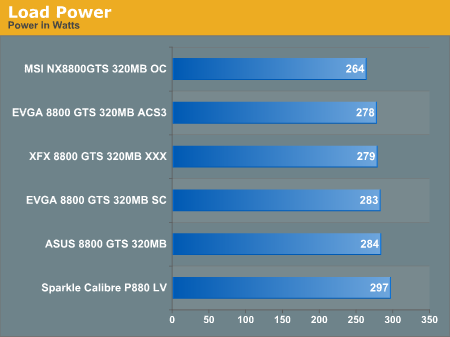
The major power offender is the Sparkle card, but that is to be expected due to the power draw of the TEC attached to the GPU. Other cards' power differences can be explained by differences in the graphics BIOS (i.e. voltages and timings) on each card.
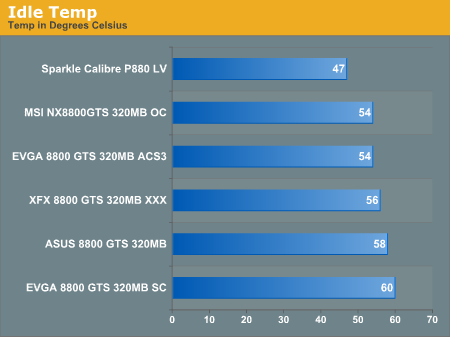
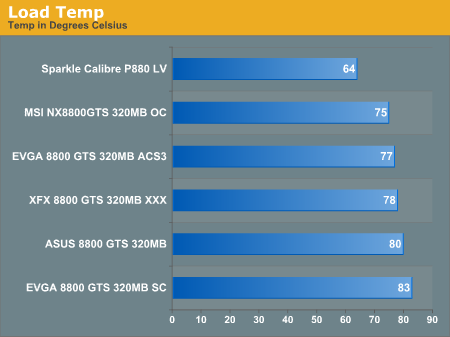
As for heat, what the Calibre lacks in power efficiency, it makes up for in temperature. This solution cools much better than the stock cooler attached to the 8800 GTS, which is nothing to sneeze at. The stock NVIDIA cooler is quite impressive at keeping hardware cool at lower noise levels, but Sparkle's setup wins the day here. With clock speeds similar to other cards, the TEC is clearly doing better when put under the same stress conditions, and we would expect end-user overclocking to be better than with stock cooling. It's unfortunate that Sparkle isn't willing to factory overclock their cards further, as that would make their offering much more attractive.
We should also mention that the ASC3 solution from EVGA didn't have that much of an impact on temperature. We do see slightly better than average cooling performance, but it's just not enough to sell us on it for cooling alone. We would once again submit that it looks cool even if it doesn't cool much better than the stock HSF.
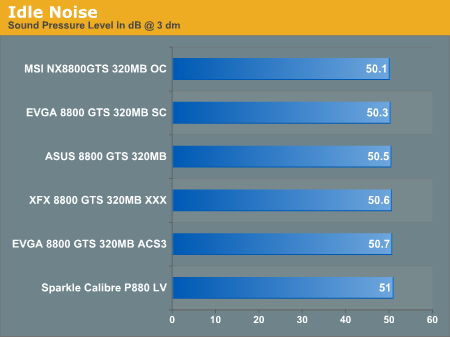
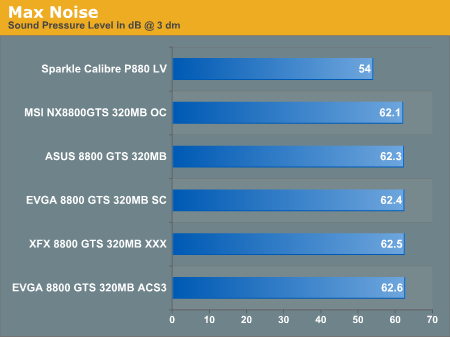
Looking at noise pollution, all these cards gave us similar noise levels at idle. Under load, most cards again came in at about the same volume, but the Sparkle Calibre P880 LV kept very quiet as it cooled the hardware more efficiently than any other card we tested. We are certainly impressed with Sparkle's use of this cooling solution. While there are some drawbacks, the advantage is clear. This card will run much cooler than a simple air cooled solution.
We would expect the GeForce 8800 GTS 320MB parts to draw less power at idle and under load as compared to the 640MB part, as it does take more power to run more RAM. Some of our numbers support this, while others are different than we would expect.


The major power offender is the Sparkle card, but that is to be expected due to the power draw of the TEC attached to the GPU. Other cards' power differences can be explained by differences in the graphics BIOS (i.e. voltages and timings) on each card.


As for heat, what the Calibre lacks in power efficiency, it makes up for in temperature. This solution cools much better than the stock cooler attached to the 8800 GTS, which is nothing to sneeze at. The stock NVIDIA cooler is quite impressive at keeping hardware cool at lower noise levels, but Sparkle's setup wins the day here. With clock speeds similar to other cards, the TEC is clearly doing better when put under the same stress conditions, and we would expect end-user overclocking to be better than with stock cooling. It's unfortunate that Sparkle isn't willing to factory overclock their cards further, as that would make their offering much more attractive.
We should also mention that the ASC3 solution from EVGA didn't have that much of an impact on temperature. We do see slightly better than average cooling performance, but it's just not enough to sell us on it for cooling alone. We would once again submit that it looks cool even if it doesn't cool much better than the stock HSF.


Looking at noise pollution, all these cards gave us similar noise levels at idle. Under load, most cards again came in at about the same volume, but the Sparkle Calibre P880 LV kept very quiet as it cooled the hardware more efficiently than any other card we tested. We are certainly impressed with Sparkle's use of this cooling solution. While there are some drawbacks, the advantage is clear. This card will run much cooler than a simple air cooled solution.










24 Comments
View All Comments
bob4432 - Wednesday, March 28, 2007 - link
obviously they are all using nvidia's reference design for the pcb and most for the cooling setup. now when a company like evga orders their multi-thousand gpu order, do they spec out what exact ram chips they want vs msi, asus or xfx? to me the cards look identical to even the purple on the solid caps we can see coming out the back. is this for the memory ics too?would i be correct in saying that you are basically picking a brand based strictly on customer service and warranty as the cards are all pretty close in performance since they are just using the nvidia design and are not designing the cards in house?
KCjoker - Tuesday, March 27, 2007 - link
I just bought a EVGA 8800GTS 320mb that came at the stock 500/1600 speeds for $260USD. I would've got the 640mb version but since I only game at 1280X1024 I didn't see the need. This card rips through games at stock but I have OC'd(600/1900) it anyway since EVGA's Lifetime warranty covers it so long as you don't physically damage the card. If you're looking for a great mid range card this is it.yyrkoon - Tuesday, March 27, 2007 - link
I dont know if I would consider ANY 8 series cards right_now "mid-range". Mid-range, in my head, that would be a 7 series card, with 6 series cards being botttom feeders.
bigpow - Tuesday, March 27, 2007 - link
do what I did, skip all the PC upgrades and just buy an Xbox 360mkruer - Tuesday, March 27, 2007 - link
I assume that the power is for the whole system. I did not read anything explicitly stating this.SleepyItes - Tuesday, March 27, 2007 - link
On the XFX page, "The XFX GeForce 8800 GTS 320MB Extreme is bundled with Ghost Recon: Advanced Warfighter just like the MSI card."Should be "...just like the Asus card."
DerekWilson - Tuesday, March 27, 2007 - link
thanksSpacecomber - Tuesday, March 27, 2007 - link
Do stock 8800 GTS cards readily overclock to the same range of speeds that these factory overclocked cards offer? Do these factory overclocked cards have the potential for more overclocking than what you can accomplish with the standard clock speed cards? In particular, didn't you guys want to know whether the Sparkle cooler offers the potential for even more overclocking, beyond what it is set to at the factory?Lonyo - Tuesday, March 27, 2007 - link
Is there any chance of getting a case mounted temp sensor for these reviews?It seems to me that you would have to make a tradeoff with the Sparkle. Sure, you get lower GPU temps, but that heat and the heat from the TEC has to go somewhere, and that somewhere is going to be "somewhere else inside the case", since it doesn't appear to have any kind of exhausting fan setup.
metalfan49 - Tuesday, March 27, 2007 - link
I was thinking about this too. Especially as summer is coming and I won't have the weather to help keep my stuff cool.